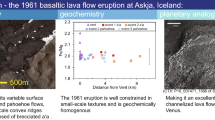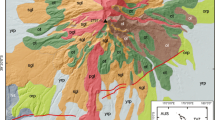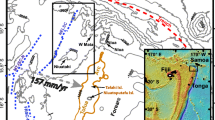Abstract
The surface morphologies (pāhoehoe and ‘a‘ā) of three short-duration, high effusion rate Kīlauean lava flows record important information about basaltic lava flow emplacement. Variations in the distributions of surface morphology with distance from the vent indicate the cumulative effects of both intrinsic (i.e. composition, temperature, crystallinity) and extrinsic (i.e. topography, effusion rate, flow velocity) parameters of emplacement. Detailed surface mapping with aerial photos and radar imagery reveal that all three flows exhibit a flow facies evolution common to Hawaiian ‘a‘ā flows of (1) pāhoehoe sheet flows, (2) ‘a‘ā-filled channels within pāhoehoe sheets, and (3) channelized ‘a‘ā. The resulting surface morphology distribution is similar among flows, although differences in the length scale of the distribution exist. We characterize the surface morphology distribution by the distance from the vent to the onset of the surface morphology transition (0.5–4 km) and the length of the transition from onset to completion (1.5–7 km). The parameters that affect surface morphology changes are investigated by comparison of two recent flows (July and December 1974). There is no correlation between the location of the surface morphology transition and local changes in slope; instead, ‘a‘ā formation initiates when flows reach a critical groundmass crystallinity of ϕ~0.18. This critical crystallinity, composed primarily of plagioclase and pyroxene microlites, does not appear to be affected by the presence or absence of olivine phenocrsyts. This crystallinity also correlates with theoretical and experimental predictions for the onset of a yield strength and supports the idea that crystal-crystal interactions are controlled primarily by the content of prismatic crystals (e.g. plagioclase). The dependence of the morphologic transition on post-eruptive crystallization requires that the down-flow location of the surface morphology transition is determined by both eruption temperature and effusion rate, with hotter, faster flows traveling greater distances before crystallizing enough to form ‘a‘ā. The length of the transition zone is proportional to the rate of flow cooling, which is dramatically influenced by topographic confinement. A comparison of the surface morphology distributions of these flows to the 1823 Keaiwa flow, which has a similar composition, pre-eruptive topography, and eruption temperature suggests that it was emplaced at effusion and flow advance rates, 300 m3/s and 1–3 m/s, respectively, typical of observed Hawaiian eruptions and much lower than previous estimates from the run-up height of lava. Evaluation of independent methods to determine flow-front velocities indicates that run-up height estimates consistently exceed estimates from tree-mold measurements and observation of active flows of <2 m/s. Channel velocities of 1–3 m/s, inferred through analysis of ‘a‘ā clinker size as a function of distance from the vent, are higher than those inferred at the flow-front.












Similar content being viewed by others
References
Anderson SW, Stofan ER, Plaut JJ, Crown DA (1998) Block size distributions on silicic lava flow surfaces: implications for emplacement conditions. Geol Soc Am Bull 110:1258–1267
Baloga S, Spudis PD, Guest JE (1995) The dynamics of rapidly emplaced terrestrial lava flows and implications for planetary volcanism. J Geophys Res 100:24509–24519
Campbell BA (2002) Radar remote sensing of planetary surfaces. Cambridge University Press, Cambridge, 331 pp
Cashman KV, Mangan MT, Newman S (1994) Surface degassing and modifications to vesicle size distributions in active basalt flows. J Volcanol Geotherm Res 61:45–68
Cashman KV, Thornber C, Kauahikaua JP (1999) Cooling and crystallization of lava in open channels, and the transition of pāhoehoe lava to ‘a‘ā. Bull Volcanol 61:306–323
Clague DA, Hagstrum JT, Champion DE, Beeson MH (1999) Kilauea summit overflows: their ages and distribution in the Puna District, Hawai`i. Bull Volcanol 61:363–381
Crisp J, Baloga S (1990) A model for lava flows with two thermal components. J Geophys Res 98:1255–1270
Crisp J, Baloga S (1994) Influence of crystallization and entrainment of cooler material on the emplacement of basaltic aa lava flows. J Geophys Res 99:11819–11831
Crisp J, Cashman KV, Bonini JA, Hougen SB, Pieri DC (1994) Crystallization history of the 1984 Mauna Loa lava flow. J Geophys Res 99:7177–7198
Dutton CE (1884) Geology of the Hawaiian islands. Bull Philos Soc Wash B6:13–14
Ellis W (1825) Narrative of a tour through Hawaii, or, Owhyhee. H. Fisher, Son, and P. Jackson, London, 264 pp
Fink JH, Griffiths RW (1992) A laboratory analog study of the surface morphology of lava flows extruded from point and line sources. J Volcanol Geotherm Res 54:19–32
Folley M (1999) Crystallinity, rheology, and surface morphology of basaltic lavas, Kilauea Volcano, Hawai`i. MS Thesis, University of Oregon, 205 pp
Gaddis LR, Mouginis-Mark PJ, Hayashi JN (1990) Lava flow surface textures: SIR-B radar image texture, field observations, and terrain measurements. Photogramm Eng Remote Sensing 56:211–224
Griffiths RW, Fink JH (1992) Solidification and morphology of submarine lavas: a dependence on extrusion rate. J Geophys Res 97:19729–719737
Guest JE, Kilburn CRJ, Pinkerton H, Duncan AM (1987) The evolution of lava flow-fields; observations of the 1981 and 1983 eruptions of Mount Etna, Sicily. Bull Volcanol 49:527–540
Guest JE, Spudis PD, Greeley R, Taylor GJ, Baloga SM (1995) Emplacement of xenolith nodules in the Kaupulehu lava flow, Hualalai Volcano, Hawaii. Bull Volcanol 57:179–184
Harris AJL, Rowland SK (2001) FLOWGO: a kinematic thermo-rheological model for lava flowing in a channel. Bull Volcanol 63:20–44
Helz RT, Thornber CR (1987) Geothermometry of Kilauea Iki lava lake, Hawaii. Bull Volcanol 49:651–668
Helz RT, Banks NG, Heliker CT, Neal CA, Wolfe EW (1995) Comparative geothermometry of recent Hawaiian eruptions. J Geophys Res 100:17637–17657
Heslop SE, Wilson L, Pinkerton H, Head JW (1989) Dynamics of a confined lava flow on Kilauea Volcano, Hawaii. Bull Volcanol 51:415–432
Hon K, Kauahikaua JP, Denlinger R, Mackay K (1994) Emplacement and inflation of pāhoehoe sheet flows: observations and measurements of active lava flows on Kilauea Volcano, Hawaii. Geol Soc Am Bull 106:351–370
Hon K, Kauahikaua J, Mackay K (1993) Inflation and cooling data from pāhoehoe sheet flows on Kilauea Volcano. US Geol Survey Open-File Report 93–342A
Hoover SR, Cashman KV, Manga M (2001) The yield strength of subliquidus basalts; experimental results. J Volcanol Geotherm Res 107:1–18
Iverson R, LaHusen RG, Major JJ, Zimmerman CL (1994) Debris flow against obstacles and bends: dynamics and deposits. EOS, Trans Am Geophys Union 75:274
Jones AE (1943) Classification of lava-surfaces. Trans Am Geophys Union:265–268
Kauahikaua, JP, Margriter S, Lockwood J, Trusdell, F (1995) Application of GIS to the estimation of lava flow hazards on Mauna Loa Volcano, Hawai'i. AGU Monogr 92:315:325
Kauahikaua JP, Cashman KV, Clague DA, Champion DE, Hagstrum JT (2002) Emplacement of the most recent lava flows on Hualalai Volcano, Hawai'i. Bull Volcanol DOI 10.1007/s00445-001-0196-8
Kilburn CR (1981) Pahoehoe and aa lavas: a discussion and continuation of the model of Peterson and Tilling. J Volcanol Geotherm Res 11:373–382
Kilburn CRJ (1990) Surfaces of aa flow-fields on Mount Etna, Sicily; morphology, rheology, crystallization and scaling phenomena. In: Fink JH (ed) Lava flows and domes. Springer, Berlin Heidelberg New York, pp 129–156
Kilburn CRJ, Lopes RMC (1991) General patterns of flow field growth: aa and blocky lavas. J Geophys Res 96:19,712–719,732
Kilburn CRJ, Guest JE (1993) Aa lavas of Mount Etna, Sicily. In: Kilburn CRJ, Luongo G (eds) Active lavas. UCL Press, London, pp 73–106
Langlas C (1990) The people of Kalapana 1823–1950: a report of the Kalapana oral history project, pp 50
Lipman PW, Banks NG (1984) 'A'a flow dynamics, Mauna Loa 1984. In: Decker RW, Wright TL, Stauffer PH (eds) Volcanism in Hawai'i. US Geol Survey Prof Pap 1350, pp 1527–1567
Lockwood JP, Tilling RI, Holcomb RT, Klein F, Okamura AT, Peterson DW (1999) Magma migration and resupply during the 1974 summit eruptions of Kilauea Volcano, Hawai`i. US Geol Survey Prof Pap 1613, 37 pp
Macdonald GA (1953) Pahoehoe, aa, and block lava. Am J Sci 251:169–191
Moore HJ, Kachadoorian R (1980) Estimates of lava-flow velocities using lava trees. Reports of Plan Geol Prog 1979–1980, pp 201–203
Moore HJ, Schaber GG (1975) An estimate of the yield strength of the Imbrium lava flows. Proc 6th Lunar Sci Conf. Pergamon Press, New York, pp 108–111
Nichols RL (1939) Viscosity of lava. J Geol 47:290–302
Peterson DW, Tilling RI (1980) Transition of basaltic lava from pāhoehoe to aa, Kilauea Volcano, Hawai'i: field observations and key factors. J Volcanol Geotherm Res 7:271–293
Philpotts AR, Shi J, Brustman C (1998) Role of plagioclase crystal chains in the differentiation of partly crystallized basaltic magma. Nature 395:343–346
Pinkerton H, Wilson L (1994) Factors controlling the lengths of channel-fed lava flows. Bull Volcanol 56:108–120
Polacci M, Cashman KV, Kauahikaua JP (1999) Textural characterization of the pāhoehoe-'a'a transition in Hawaiian basalt. Bull Volcanol 60:595–609
Pouchou J, Pichoir F (1991) Quantitative analysis of homogeneous or stratified microvolumes applying the model "PAP". In: Heinrich KFJ, Newbury DE (eds) Electron probe quantitation. Plenum Press, New York
Rowland SK, Walker GPL (1990) Pahoehoe and aa in Hawaii: volumetric flow rate controls the lava structure. Bull Volcanol 52:615–628
Rowland SK, Walker GPL (1987) Toothpaste lava: characteristics and origin of a lava structural type transitional between pahoehoe and aa. Bull Volcanol 49:631–641
Saar MO, Manga M, Cashman KV, Fermouw S (2001) Numerical models of the onset of yield strength in crystal-melt suspensions. Earth Planet Sci Lett 187:367–379
Sparks RSJ, Pinkerton H, Hulme G (1976) Classification and formation of lava levees on Mount Etna, Sicily. Geology 4:269–271
Stearns HT (1926) The Keaiwa or 1823 lava flow from Kilauea Volcano, Hawaii. J Geol 34:336–351
Swanson DA (1973) Pahoehoe flows from the 1969–1971 Mauna Ulu eruption, Kilauea Volcano, Hawaii. Geol Soc Am Bull 84:615–626
USGS (1981) Kau Desert quadrangle, Hawaii. 1:24,000. 7.5 minute series (topographic). Washington, DC
Wadge G, Young PAV, McKendrick IJ (1994) Mapping lava flow hazards using computer simulation. J Geophys Res 99:489–504
Wentworth CK, Macdonald GA (1953) Structures and forms of basaltic rocks in Hawai'i. US Geol Survey Bull 994, 98 pp
Wolfe EW, Neal CA, Banks NG, Duggan TJ (1988) Geologic observations and chronology of eruptive events. In: Wolfe EW (ed) The Puu Oo eruption of Kilauea Volcano, Hawaii: episodes 1 through 20, January 3, 1983, through June 8, 1984. US Geol Survey Prof Pap 1463, pp 1–99
Acknowledgements
The authors gratefully thank the staff of the Hawaiian Volcano Observatory for logistical and material support in the undertaking of this work and Randy Cabral of Ka'u Orchards for access to their property. Scott Rowland, Steven Blake, and John Stix provided thoughtful reviews of this manuscript. Additionally, we thank colleagues, Don Swanson, Bob Tilling, Jack Lockwood, Michael Manga, and Ross Griffiths for helpful discussions. This work was supported by NSF EAR-9902851 (to K.V.C.).
Author information
Authors and Affiliations
Corresponding author
Additional information
Editorial responsibility: J. Stix
Rights and permissions
About this article
Cite this article
Soule, S.A., Cashman, K.V. & Kauahikaua, J.P. Examining flow emplacement through the surface morphology of three rapidly emplaced, solidified lava flows, Kīlauea Volcano, Hawai'i. Bull Volcanol 66, 1–14 (2004). https://doi.org/10.1007/s00445-003-0291-0
Received:
Accepted:
Published:
Issue Date:
DOI: https://doi.org/10.1007/s00445-003-0291-0




